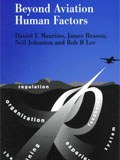Beyond Aviation Human Factors
Beyond Aviation Human Factors

This book is intended to provide a bridge from the academic knowledge gained from research, to the needs of practitioners in aviation. It comprises six chapters; the fundamentals, background and justification for an organizational accident causation model to the flight deck, maintenance and air traffic control environments. The last chapter suggest different ways to apply the model as a prevention tool which furthermore enhances organizational effectiveness. The value of the organizational framework pioneered by Professor Reason in analyzing safety in high-technology production systems is felt by his co-authors to have an enduring role to play, both now and in coming decades. Applied now in this book, it has been adopted by ICAO, IFATCA, IMO, the US National Transportation Safety Board, the Transportation Safety Board of Canada, the Bureau of Air Safety Investigation, (BASI, Australia) and British Airways, among others. Every effort has been made to ensure that the book is both relevant to the operational environment. The readership includes aviation management, pilots, air traffic controllers, maintenance engineers, accident investigators and civil aviation authorities; training, operational, non-technical and quality control personnel in aviation, other modes of transportation and other high-technology production industries.








